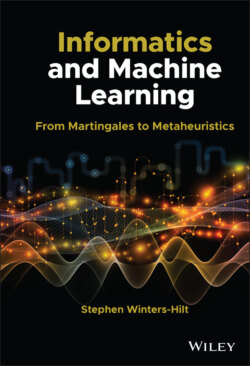Читать книгу Informatics and Machine Learning - Stephen Winters-Hilt - Страница 48
3.1.3 Relative Entropy and Its Uniqueness
ОглавлениеRelative entropy (ρ = ∑xp(x) log(p(x)/q(x)) = D(P||Q)) uniquely results from a geometric (differentiable manifold) formalism on families of distributions – the Information Geometry formalism was first described by Amari [113–115]. Together with Laplace’s principle of insufficient reason on the choice of “reference” distribution in the relative entropy expression, this will reduce to Shannon entropy, and thus uniqueness on Shannon entropy from a geometric context. The parallel with geometry is the Euclidean distance for “flat” geometry (simplest assumption of structure), vs. the “distance” between distributions as described by the Kullback–Leibler divergence.
When comparing discrete probability distributions P and Q, both referring to the same N outcomes, the measure of their difference is sometimes measured in terms of their symmetrized relative entropy [105] (a.k.a. Kullback–Leibler divergence), D(P,Q):
where,
where, P and Q have outcome probabilities {pk} and {qk}.
Relative entropy has some oddities that should be explained right away. First, it does not have the negative sign in front to make it a positive number (recall this was done for the Shannon entropy definition since all of the log factors are always negative). Relative entropy does not need the negative sign, however, since it is provably always positive as is! (The proof uses Jensen’s Inequality from Section 2.6.1, see Exercise 3.12.) For relative entropy there is also the constraint to the convention mentioned above where all the outcome probabilities are nonzero (otherwise have a divide by zero or a log(0) evaluation, either of which is undefined). Relative entropy is also asymmetric in that D(P‖Q) is not equal to D(Q‖P).
